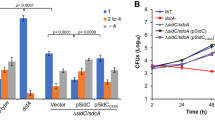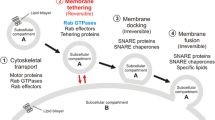Abstract
FtsE is one of the earliest cell division proteins that assembles along with FtsX at the mid-cell site during cell division in Escherichia coli. Both these proteins are highly conserved across diverse bacterial genera and are predicted to constitute an ABC transporter type complex, in which FtsE is predicted to bind ATP and hydrolyse it, and FtsX is predicted to be an integral membrane protein. We had earlier reported that the MtFtsE of the human pathogen, Mycobacterium tuberculosis, binds ATP and interacts with MtFtsX on the cell membrane of M. tuberculosis and E. coli. In this study, we demonstrate that MtFtsE is an ATPase, the active form of which is a dimer, wherein the participating monomers are held together by non-covalent interactions, with the Cys84 of each monomer present at the dimer interface. Under oxidising environment, the dimer gets stabilised by the formation of Cys84–Cys84 disulphide bond. While the recombinant MtFtsE forms a dimer on the membrane of E. coli, the native MtFtsE seems to be in a different conformation in the M. tuberculosis membrane. Although disulphide bridges were not observed on the cytoplasmic side (reducing environment) of the membrane, the two participating monomers could be isolated as dimers held together by non-covalent interactions. Taken together, these findings show that MtFtsE is an ATPase in the non-covalent dimer form, with the Cys84 of each monomer present in the reduced form at the dimer interface, without participating in the dimerisation or the catalytic activity of the protein.







Similar content being viewed by others
Abbreviations
- ABC:
-
ATP binding cassette
- ATP:
-
Adenosine triphosphate
- ADP:
-
Adenosine diphosphate
- Fts:
-
Filamenting temperature sensitive
- NBD:
-
Nucleotide binding domain
- TMD:
-
Trans membrane domain
- DTT:
-
Dithiothreitol
- IPTG:
-
Isopropylthio-β-d-galactoside
- LB broth:
-
Luria–Bertani broth
- PBS:
-
Phosphate buffered saline
- PMSF:
-
Phenyl methyl sulphonyl fluoride
- CuP:
-
Cupric phenanthroline
- DTSP:
-
3,3′-Dithio-bispropionic acid di (N-hydroxysuccinimide ester)
- SDS-PAGE:
-
Sodium dodecyl sulphate-polyacrylamide gel electrophoresis
- β-ΜΕ:
-
β-Mercaptoethanol
- MBP:
-
Maltose binding protein
References
Schmidt KL, Peterson ND, Kustusch RJ, Wissel MC, Graham B, Phillips GJ, Weiss DS (2004) A predicted ABC transporter, FtsEX, is needed for cell division in Escherichia coli. J Bacteriol 186:785–793
Braibant M, Gilot P, Content J (2000) The ATP binding cassette (ABC) transport systems of Mycobacterium tuberculosis. FEMS Microbiol Rev 24:449–467
Ambudkar SV, Kim IW, Xia D, Sauna ZE (2006) The A-loop, a novel conserved aromatic acid subdomain upstream of the Walker A motif in ABC transporters, is critical for ATP binding. FEBS Lett 580:1049–1055
Smith PC, Karpowich N, Millen L, Moody JE, Rosen J, Thomas PJ, Hunt JF (2002) ATP binding to the motor domain from an ABC transporter drives formation of a nucleotide sandwich dimer. Mol Cell 10:139–149
Loo TW, Bartlett MC, Clarke DM (2002) The “LSGGQ” motif in each nucleotide-binding domain of human P-glycoprotein is adjacent to the opposing walker A sequence. J Biol Chem 277:41303–41306
de Leeuw E, Graham B, Phillips GJ, ten Hagen-Jongman CM, Oudega B, Luirink J (1999) Molecular characterisation of Escherichia coli FtsE and FtsX. Mol Microbiol 31:983–993
Mir MA, Rajeswari HS, Veeraraghavan U, Ajitkumar P (2006) Molecular characterisation of ABC transporter type FtsE and FtsX proteins of Mycobacterium tuberculosis. Arch Microbiol 185:147–158
Sham LT, Barendt SM, Kopecky KE, Winkler ME (2011) Essential PcsB putative peptidoglycan hydrolase interacts with the essential FtsXSpn cell division protein in Streptococcus pneumoniae D39. Proc Natl Acad Sci USA 108:E1061–E1069
Yang DC, Peters NT, Parzych KR, Uehara T, Markovski M, Bernhardt TG (2011) An ATP-binding cassette transporter-like complex governs cell-wall hydrolysis at the bacterial cytokinetic ring. Proc Natl Acad Sci USA 108:E1052–E1060
Meisner J, Montero Llopis P, Sham LT, Garner E, Bernhardt TG, Rudner DZ (2013) FtsEX is required for CwlO peptidoglycan hydrolase activity during cell wall elongation in Bacillus subtilis. Mol Microbiol 89:1069–1083
Arends SJ, Kustusch RJ, Weiss DS (2009) ATP-binding site lesions in FtsE impair cell division. J Bacteriol 191:3772–3784
Gill DR, Salmond GP (1987) The Escherichia coli cell division proteins FtsY, FtsE and FtsX are inner membrane-associated. Mol Gen Genet 210:504–508
Ukai H, Matsuzawa H, Ito K, Yamada M, Nishimura A (1998) ftsE(Ts) affects translocation of K+-pump proteins into the cytoplasmic membrane of Escherichia coli. J Bacteriol 180:3663–3670
Reddy M (2007) Role of FtsEX in cell division of Escherichia coli: viability of ftsEX mutants is dependent on functional SufI or high osmotic strength. J Bacteriol 189:98–108
Guzman LM, Belin D, Carson MJ, Beckwith J (1995) Tight regulation, modulation, and high-level expression by vectors containing the arabinose PBAD promoter. J Bacteriol 177:4121–4130
Randerath E, Randerath K (1967) Ion-exchange thin-layer chromatography: XVI. Techniques for preparation and analysis of oligonucleotides. J Chromatogr 31:485–499
Oudot C, Jaquinod M, Cortay JC, Cozzone AJ, Jault JM (1999) The isocitrate dehydrogenase kinase/phosphatase from Escherichia coli is highly sensitive to in vitro oxidative conditions role of cysteine67 and cysteine108 in the formation of a disulfide-bonded homodimer. Eur J Biochem 262:224–229
Zhang Y, Fillingame RH (1995) Subunits coupling H+ transport and ATP synthesis in the Escherichia coli ATP synthase. Cys–Cys cross-linking of F1 subunit epsilon to the polar loop of F0 subunit c. J Biol Chem 270:24609–24614
Hunke S, Mourez M, Jehanno M, Dassa E, Schneider E (2000) ATP modulates subunit-subunit interactions in an ATP-binding cassette transporter (MalFGK2) determined by site-directed chemical cross-linking. J Biol Chem 275:15526–15534
Kobashi K (1968) Catalytic oxidation of sulfhydryl groups by o-phenanthroline copper complex. Biochim Biophys Acta 158:239–245
Berman HM, Westbrook J, Feng Z, Gilliland G, Bhat TN, Weissig H, Shindyalov IN, Bourne PE (2000) The protein data bank. Nucleic Acids Res 28:235–242
Diederichs K, Diez J, Greller G, Muller C, Breed J, Schnell C, Vonrhein C, Boos W, Welte W (2000) Crystal structure of MalK, the ATPase subunit of the trehalose/maltose ABC transporter of the archaeon Thermococcus litoralis. EMBO J 19:5951–5961
Laskowski RA, Rullmannn JA, MacArthur MW, Kaptein R, Thornton JM (1996) AQUA and PROCHECK-NMR: programs for checking the quality of protein structures solved by NMR. J Biomol NMR 8:477–486
Cohen GH (1997) ALIGN: a program to superimpose protein coordinates, accounting for insertions and deletions. J Appl Cryst 30:1160–1161
Hubbard SJ, Campbell SF, Thornton JM (1991) Molecular recognition: conformational analysis of limited proteolytic sites and serine proteinase protein inhibitors. J Mol Biol 220:507–530
Shi J, Blundell TL, Mizuguchi K (2001) FUGUE: sequence-structure homology recognition using environment-specific substitution tables and structure-dependent gap penalties. J Mol Biol 310:243–257
Hopfner KP, Karcher A, Shin DS, Craig L, Arthur LM, Carney JP, Tainer JA (2000) Structural biology of Rad50 ATPase: ATP-driven conformational control in DNA double-strand break repair and the ABC-ATPase superfamily. Cell 101:789–800
Chen J, Lu G, Lin J, Davidson AL, Quiocho FA (2003) A tweezers-like motion of the ATP-binding cassette dimer in an ABC transport cycle. Mol Cell 12:651–661
Collet JF, Bardwell JC (2002) Oxidative protein folding in bacteria. Mol Microbiol 44:1–8
Nikaido K, Liu PQ, Ames GF (1997) Purification and characterization of HisP, the ATP-binding subunit of a traffic ATPase (ABC transporter), the histidine permease of Salmonella typhimurium. Solubility, dimerisation, and ATPase activity. J Biol Chem 272:27745–27752
Schneider E, Hunke S (1998) ATP-binding-cassette (ABC) transport systems: functional and structural aspects of the ATP-hydrolysing subunits/domains. FEMS Microbiol Rev 22:1–20
Reich-Slotky R, Panagiotidis C, Reyes M, Shuman HA (2000) The detergent-soluble maltose transporter is activated by maltose binding protein and verapamil. J Bacteriol 182:993–1000
Liu PQ, Ames GF (1998) In vitro disassembly and reassembly of an ABC transporter, the histidine permease. Proc Natl Acad Sci USA 95:3495–3500
Heras B, Shouldice SR, Totsika M, Scanlon MJ, Schembri MA, Martin JL (2009) DSB proteins and bacterial pathogenicity. Nat Rev Microbiol 7:215–225
McIntosh PR, Freedman RB (1980) Characteristics of a copper-dependent cross-linking reaction between two forms of cytochrome P-450 in rabbit-liver microsomal membranes. Biochem J 187:227–237
Tsumoto K, Umetsu M, Kumagai I, Ejima D, Philo JS, Arakawa T (2004) Role of arginine in protein refolding, solubilisation, and purification. Biotechnol Prog 20:1301–1308
Nikaido K, Ames GF (1999) One intact ATP-binding subunit is sufficient to support ATP hydrolysis and translocation in an ABC transporter, the histidine permease. J Biol Chem 274:26727–26735
Chen CA, Cowan JA (2003) Characterization of the soluble domain of the ABC7 type transporter Atm1. J Biol Chem 278:52681–52688
Morbach S, Tebbe S, Schneider E (1993) The ATP-binding cassette (ABC) transporter for maltose/maltodextrins of Salmonella typhimurium. Characterisation of the ATPase activity associated with the purified MalK subunit. J Biol Chem 268:18617–18621
Treptow NA, Shuman HA (1985) Genetic evidence for substrate and periplasmic-binding-protein recognition by the MalF and MalG proteins, cytoplasmic membrane components of the Escherichia coli maltose transport system. J Bacteriol 163:654–660
Bishop L, Agbayani R Jr, Ambudkar SV, Maloney PC, Ames GF (1989) Reconstitution of a bacterial periplasmic permease in proteoliposomes and demonstration of ATP hydrolysis concomitant with transport. Proc Natl Acad Sci USA 86:6953–6957
Anderson MP, Berger HA, Rich DP, Gregory RJ, Smith AE, Welsh MJ (1991) Nucleoside triphosphates are required to open the CFTR chloride channel. Cell 67:775–784
Liu CE, Ames GF (1997) Characterisation of transport through the periplasmic histidine permease using proteoliposomes reconstituted by dialysis. J Biol Chem 272:859–866
Hobson AC, Weatherwax R, Ames GF (1984) ATP-binding sites in the membrane components of histidine permease, a periplasmic transport system. Proc Natl Acad Sci USA 81:7333–7337
Higgins CF, Hiles ID, Whalley K, Jamieson DJ (1985) Nucleotide binding by membrane components of bacterial periplasmic binding protein-dependent transport systems. EMBO J 4:1033–1039
Arumugam M, Ajitkumar P (2012) Histidine 117 in the His-Gly-Ser-Asp motif is required for the biochemical activities of nucleoside diphosphate kinase of Mycobacterium smegmatis. Open Biochem J 6:71–77
Acknowledgments
MAM thanks Prof. Keith M. Derbyshire, Division of Genetics, Wadsworth Center, Albany, New York, USA, for critical comments on the manuscript. This work was carried out using the ICMR research Grant No. 63/72/2001-BMS to PA and the infrastructural facilities provided by the DBT-supported Genomics Initiative on Microbial Pathogens–Structural Genomics Initiative in the Division of Biological Sciences, Indian Institute of Science, the DST-FIST and UGC-CAS at the Department of Microbiology and Cell Biology, Indian Institute of Science. The authors acknowledge the facilities at the erstwhile DBT-funded Bioinformatics Centre at IISc.
Author information
Authors and Affiliations
Corresponding author
Rights and permissions
About this article
Cite this article
Mir, M.A., Arumugam, M., Mondal, S. et al. Mycobacterium tuberculosis Cell Division Protein, FtsE, is an ATPase in Dimeric Form. Protein J 34, 35–47 (2015). https://doi.org/10.1007/s10930-014-9593-7
Published:
Issue Date:
DOI: https://doi.org/10.1007/s10930-014-9593-7




